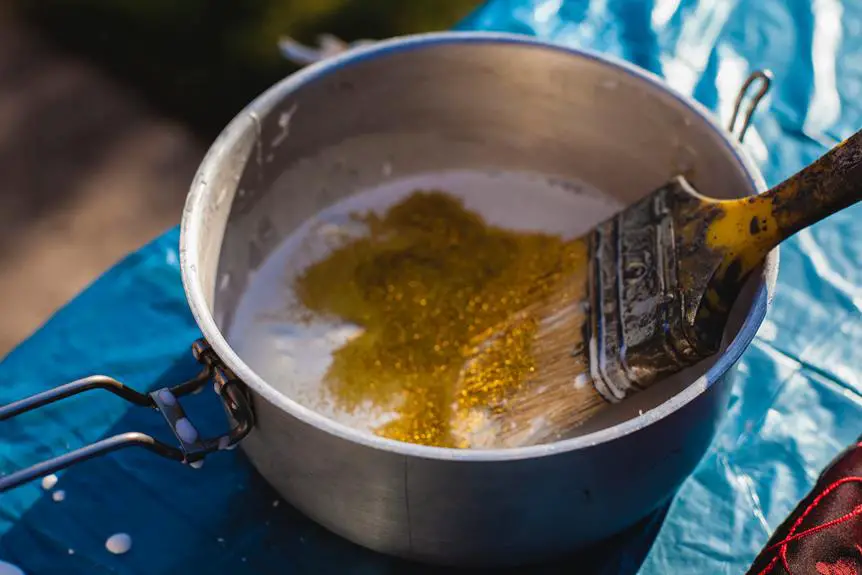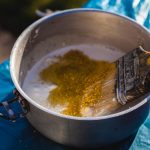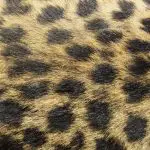Curious if hot glue can securely stick to stucco? Let's delve into the truth of this matter.
When mastering the art of adhesion, understanding the texture of the stucco surface is crucial. Factors such as surface roughness and composition can impact the effectiveness of hot glue.
Preparing the stucco surface and employing the right application techniques are key for successful adhesion.
Safety should also be a priority when using hot glue on stucco.
In this guide, we'll explore the intricacies of hot glue adhesion to stucco, providing you with the knowledge and expertise needed for this unique application.
Key Takeaways
- Stucco surface texture affects its adhesive properties, with rougher textures providing more surface area for adhesion.
- Properly preparing the stucco surface, including cleaning and priming, ensures strong adhesion of hot glue.
- Hot glue may not be as resistant to extreme temperatures and weather conditions, requiring additional measures to protect the bond.
- Safety considerations include understanding stucco's heat resistance and potential surface damage upon hot glue removal.
Understanding Stucco Surface Texture
To understand stucco surface texture, run your hand along the wall to feel the roughness or smoothness of the surface. Stucco, a popular exterior finish, offers a range of surface textures, from coarse to smooth. The texture not only contributes to the aesthetic appeal of a building but also plays a crucial role in its adhesive properties.
The stucco surface, whether troweled, swirled, or sprayed, affects its adhesive properties. A rougher texture provides more surface area for adhesion, making it easier for adhesives to bond with the stucco. On the other hand, a smooth stucco surface may require additional preparation, such as scoring or roughening, to enhance its adhesive capabilities. Understanding the surface texture is essential when considering options for adhering materials to stucco, as it directly impacts the effectiveness of the adhesion.
Factors Affecting Hot Glue Adhesion
You need to consider the temperature of the stucco surface when using hot glue, as it can affect the adhesive strength.
Weather conditions and humidity play a significant role in hot glue adhesion to stucco. High humidity can impact the drying time and bonding quality of hot glue, especially on stucco surfaces.
The type of hot glue used also influences its adhesive strength. Different hot glue formulations are designed for specific applications and materials. It's crucial to select a hot glue that's suitable for outdoor use and is compatible with stucco surfaces.
In addition to weather conditions and the type of hot glue, the temperature of the stucco surface is a critical factor in determining the adhesive strength of hot glue. Extreme temperatures, whether hot or cold, can compromise the adhesive properties of hot glue. It's essential to apply hot glue to stucco surfaces within the recommended temperature range specified by the hot glue manufacturer.
Preparing the Stucco Surface for Hot Glue
Ensure the stucco surface is clean and free from dust and debris before applying hot glue. Proper preparation of the stucco surface is crucial to ensure strong adhesion of the hot glue. Here are some essential steps to prepare the stucco surface for hot glue application:
- Stucco cleaning: Thoroughly clean the stucco surface using a mild detergent and water. Use a scrub brush or sponge to remove any dirt, grime, or loose particles. Rinse the surface with clean water and allow it to dry completely before proceeding to the next step.
- Surface priming: Apply a suitable primer designed for stucco surfaces. The primer helps create a uniform surface and enhances the adhesion of the hot glue. Follow the manufacturer's instructions for the application of the primer and ensure it's completely dry before applying hot glue.
- Inspect for imperfections: Before applying hot glue, inspect the stucco surface for any imperfections such as cracks or uneven areas. Repair any damage and ensure the surface is smooth and even to promote strong and durable adhesion of the hot glue.
Following these steps will ensure that the stucco surface is properly prepared for hot glue application, allowing for optimal adhesion and longevity of the bond.
Application Techniques for Hot Glue on Stucco
When applying hot glue to stucco, it's essential to use a consistent and even application technique to ensure secure adhesion. Start by cleaning the stucco surface thoroughly to remove any dust, dirt, or debris that could interfere with the adhesive strength of the hot glue.
Once the surface is clean and dry, apply the hot glue in a continuous bead or a series of evenly spaced dots, depending on the size and weight of the object you're attaching. Press the object firmly onto the hot glue while it's still warm to ensure a strong bond.
In terms of weather resistance, hot glue is generally not as resistant to extreme temperatures and weather conditions as other adhesives. If you live in an area with significant temperature variations or frequent exposure to rain or humidity, it's important to consider additional measures to protect the hot glue bond, such as sealing the edges with a waterproof sealant or applying a weather-resistant coating over the glued area.
Safety Considerations When Using Hot Glue
When using hot glue on stucco, it's important to consider the heat resistance of the stucco and the potential for surface damage.
Understanding the safety considerations can help you avoid any issues that may arise from using hot glue on stucco surfaces.
Heat Resistance of Stucco
Stucco's heat resistance determines its safety for hot glue adhesion. Understanding the temperature tolerance and thermal expansion of stucco is crucial when considering its bonding capabilities with hot glue.
When using hot glue on stucco, consider the following:
- Thermal Expansion: Stucco's ability to withstand temperature changes without significant expansion or contraction is vital for the long-term adhesion of hot glue.
- Temperature Tolerance: Stucco's capacity to endure high temperatures without deforming or breaking down is essential for the effectiveness of hot glue adhesion.
- Bonding: The stucco's composition and texture play a significant role in how well hot glue can bond to its surface, impacting the overall strength and durability of the bond.
Knowing these factors will help you make informed decisions regarding the safety and effectiveness of using hot glue on stucco surfaces.
Potential Surface Damage
To ensure the safety and longevity of your hot glue adhesion to stucco, it's crucial to consider the potential for surface damage caused by the adhesive application. While hot glue can adhere to stucco, it may cause damage upon removal, such as pulling off paint or stucco finish. This potential risk should be carefully weighed against the benefits of using hot glue.
Stucco maintenance is essential in mitigating the risk of surface damage. Regular inspections and repairs can help identify and address any issues caused by adhesive applications.
Additionally, considering adhesive alternatives, such as construction adhesive or outdoor mounting tape, can help minimize the potential for surface damage while still achieving a secure bond.
Tips for Removing Hot Glue From Stucco
You can effectively remove hot glue from stucco by using a solvent. When dealing with hot glue residue on stucco, it's essential to use the right methods to avoid damaging the surface. Here are some tips for removing hot glue from stucco:
- Apply a Solvent: Start by applying a solvent, such as isopropyl alcohol or acetone, to the hot glue residue. Use a clean cloth to gently dab the solvent onto the affected area. Allow the solvent to penetrate the glue for a few minutes.
- Gently Scrape the Glue: After the solvent has had time to work, use a plastic scraper or an old credit card to gently scrape away the softened hot glue. Be careful not to apply too much pressure, as this could damage the stucco.
- Clean the Area: Once the hot glue has been removed, use a mild detergent and water to clean the stucco surface. Gently scrub the area with a soft brush or cloth to ensure that any remaining residue is completely removed.
Following these tips will help you effectively remove hot glue from stucco without causing damage to the surface.
Frequently Asked Questions
Can Hot Glue Be Used on Stucco Surfaces That Have Been Painted or Sealed?
Yes, hot glue can adhere to painted stucco, providing a temporary bond. However, on sealed stucco, its bonding strength may be compromised. Consider alternative adhesive options like construction adhesive for a more secure and lasting bond.
Will Hot Glue Affect the Integrity of the Stucco Surface Over Time?
Applying hot glue to stucco may not affect surface integrity long-term. Ensure proper surface prep and check material compatibility. Adhesion strength can vary, so test in inconspicuous area first.
What Types of Outdoor Weather Conditions Can Hot Glue Withstand on Stucco?
Hot glue demonstrates impressive outdoor durability and temperature resistance on stucco surfaces. Withstanding various weather conditions, it effectively adheres to stucco without compromising its integrity, making it a reliable solution for outdoor projects.
Are There Any Specific Types of Hot Glue That Are Recommended for Use on Stucco?
For stucco, recommended hot glue types are those labeled for outdoor use, like high-temperature or weatherproof variants. However, consider alternative adhesion methods such as construction adhesive or masonry screws for a more secure bond.
Can Hot Glue Be Used to Adhere Heavy Objects to Stucco Surfaces?
When adhering heavy objects to stucco, consider hot glue alternatives such as construction adhesive. Ensure the stucco surface is clean and dry before application. Prep the surface with a primer designed for stucco to enhance adhesion.
- What Does Nylon Belong To? - April 19, 2024
- What Is a Nylon Answer? - April 19, 2024
- What Is Nylon Short For? - April 19, 2024








